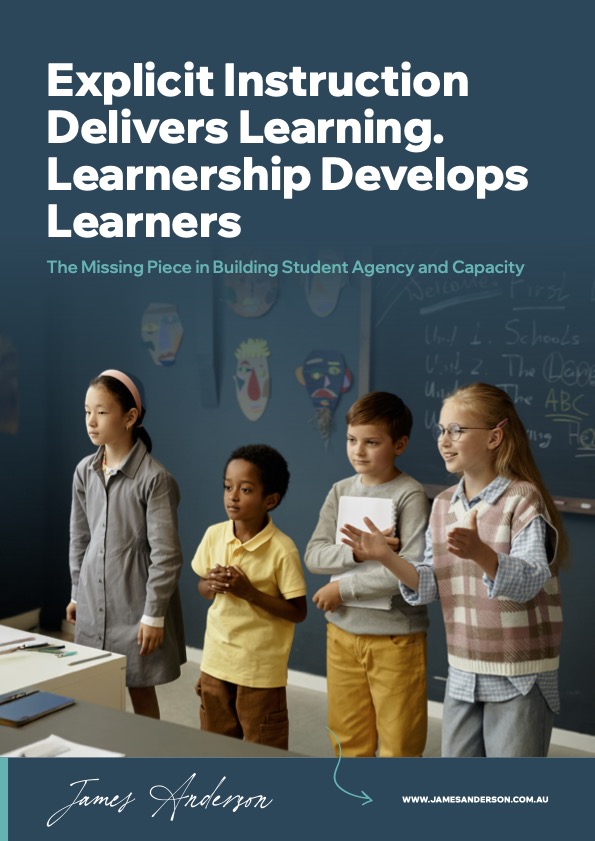The Missing Half of the Equation
You’ve done the work. Your school has embraced Explicit Instruction, and the results are clear. Lessons are sharper. Expectations clearer. Teachers more confident. By every system measure, you’re succeeding.
And yet, you may have noticed something.
Walk into any classroom and you’ll see students completing tasks with precision, but hesitating when faced with open-ended problems. They wait for the “I Do” before starting. They excel at structured assessments but struggle to transfer that learning to new contexts. They’re advancing through the curriculum—but not necessarily advancing as learners.
Too often, they slip into passivity—compliant, even dependent.
You’re achieving the learning without developing the learners.
You’re not wrong. And you’re certainly not alone.
Teaching’s Hidden Limit
We rarely pause to recognise this: even the most expertly delivered Explicit Instruction produces limited results when students haven’t developed the skills to engage with learning itself. We’ve refined our teaching methods to near perfection, but we’ve treated the learner as a constant—as if their ability to learn was fixed rather than something that could be cultivated.
Think about your highest-achieving students. They don’t just follow your carefully scaffolded lessons. They’re reflecting on mistakes, seeking out feedback, choosing effective strategies, and investing effort strategically. They’re not just receiving your excellent teaching; they’re multiplying its impact.
They haven’t yet developed the fundamental capability that determines long-term success: Learnership.
Now consider the others—the ones who succeed when you’re in control but flounder when you step back. These aren’t struggling students; by traditional measures, they’re achieving well. But they haven’t yet developed the fundamental capability that determines long-term success: Learnership.
The Missing Multiplier
Learnership isn’t another program to implement or framework to master. It’s the missing multiplier in what I call the Learning Equation:

You’ve maximised the first variable.
Without developing the second, even your best teaching operates at half capacity.
Learnership is the expertise students develop in learning itself. It’s what transforms effort into growth, mistakes into insights, and feedback into strategy. It’s the difference between students who need constant guidance and those who become genuinely self-directed. Between those who avoid challenge and those who embrace it. Between performing well at school and thriving beyond it.
I’ve explored this concept more deeply in a white paper that unpacks exactly how this works in practice—but the core insight is this: we need to develop learners, not just deliver learning.
When Students Carry the Load
Schools that cultivate Learnership alongside Explicit Instruction report something remarkable: teachers find themselves teaching less, yet students learn more. Not because teachers lower standards or reduce effort, but because students begin carrying their share of the learning load.
Students stop waiting for the “I Do” and start asking “How might I approach this?” They move from avoiding mistakes to analysing them. From receiving feedback to asking for advice. From complying with learning to leading it.
Teachers find themselves teaching less, yet students learn more.
And here’s what matters most for you as a leader: this isn’t about replacing your Explicit Instruction success. It’s about making that success sustainable. When students develop Learnership, they don’t just meet current expectations—they exceed them. They perform better on traditional assessments while building the capacity to thrive when scaffolding is removed.
Your Leadership Opportunity
You don’t need to abandon what’s working. You don’t need another initiative. You need to complete what you’ve started.
The same precision you’ve brought to teaching can be applied to developing learners. The same clarity that transformed your instruction can transform how students engage with learning.
Your role now is to ensure your school develops skilful learners, not just delivers skilful teaching.
This means shifting the conversation from “What are we teaching?” to “How are students learning to learn?” It means valuing not just curriculum outcomes, but the process of becoming capable learners.
Take the Next Step
I’ve captured the complete framework in “Explicit Instruction Delivers Learning. Learnership Develops Learners”—a comprehensive white paper that reveals why even successful schools hit invisible ceilings, what’s happening when students stay passive despite excellent teaching, and how to develop the missing half of the Learning Equation.
Schools that have applied these insights are reporting not just stronger results, but a deeper cultural change. Students are becoming capable, self-improving learners who thrive beyond the classroom.
I’d encourage you to read it and share it with your leadership team. It offers practical steps for ensuring your Explicit Instruction success doesn’t stall at compliance but grows into genuine learner agency.
Because your students deserve more than excellent teaching—they deserve to become excellent learners.
